Editor’s note: This is one in a series of articles looking back on the department’s
first 25 years—remembering the people, issues and cultural forces that have
shaped the agency and the milestones Mn/DOT has achieved.
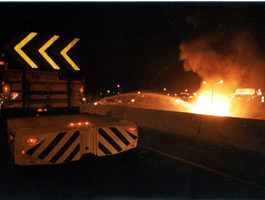 |
|
Mn/DOT maintenance forces
from the Metro Division provided traffic control and other support when
a tanker carrying naptha exploded and burned in St. Paul. Photo by
Dave Gonzalez
|
Alone in her snowbound car, afraid and in danger of freezing, Tari Ritter wrapped
a baby blanket around her head, covered her lap with an old rug and stuffed
her waist-length hair into the sleeves of her jacket. Like hundreds of other
motorists forced off the road by a fierce, fast-moving blizzard on Feb. 4, 1984,
Ritter was in trouble.
Ritter had been visiting her daughter in the Graceville Hospital. But only
minutes after leaving there, her car spun out of control leaving Ritter in the
ditch along Hwy 75 between Graceville and her home in Clinton.
She spent the next 13 hours in the car without heat. Shortly after morning
light, Ritter’s precarious situation ended. Driving with head out of his snowplow’s
window and straining to see, Charlie Stein spotted Ritter’s car. Stein, a transportation
generalist at Ortonville, had been patrolling Hwy 75 for hours looking for stranded
cars.
After reuniting Ritter with her family at the hospital, Stein went back on
patrol. Later that morning he found a van carrying four Cub Scouts, two of their
leaders and another stranded motorist. Pushing on, Stein discovered another
car with its driver dead at the wheel from an apparent heart attack.
While Stein was searching along Hwy 75, his co-workers were performing the
same daunting, exhausting task throughout Western Minnesota.
The storm, known as a "ground blizzard," developed quickly on a Saturday
afternoon, catching many people who had left home to go shopping or out to dinner
unaware.
Arvid Lovig, the maintenance superintendent at Morris who directed the rescue
efforts, said the efforts made by Stein typify Mn/DOT employees' sense of responsiblity,
work ethic and quiet courage.
Lloyd Easterday, a transportation generalist at Lakefield, had his own close
call during the blizzard. Driving from Lakefield to Sioux Falls with his spouse,
Easterday’s pickup truck went in the ditch when the storm hit them on I-90.
After their truck went off the road, a car carrying a couple from Iowa came
to rest beside them. For 13 hours the two couples huddled together, their lives
saved by the gear the Easterdays kept in their truck.
They were found at 10:30 a.m. by workers from the Worthington Truck Station.
By 11 a.m., Easterday was back at the wheel of a snowplow, supporting the rescue
effort that lasted until late that evening.
The storm took several lives. Without the effort of Mn/DOT employees and other
rescuers, the toll would have been much higher. Actions by Stein and Easterday
exemplify the countless efforts made voluntarily by Mn/DOT people to aid their
fellow citizens since the department was created in 1976.
 |
|
Arvid Lovig, retired
maintenance superintendent at Morris. Photo by Rob Sheppard
|
Halloween storm brings frightening challenge
During the Halloween Storm of 1991, for example, hundreds of Mn/DOT people
worked virtually around the clock to recover from its effects. Snow falling
on the warm pavement in the Twin Cities metro area quickly turned to ice and
bonded with the pavement. The combination made snow removal extremely difficult,
said Bob Wryk, a Metro Division superintendent who was then a supervisor at
the Camden Truck Station in north Minneapolis.
In some places, Wryk recalled, snow was compacted to a depth of six inches.
Supported by crews and graders from Greater Minnesota, maintenance forces worked
around the clock for several days to clear ice- and snow-covered roadways.
"We had long days and long nights, but people responded well. Maintenance
people tend to shine best under the most stressful conditions," he said.
Four years later, the wind struck with more fury at Itasca State Park toppling
thousands of trees and isolating campers in the park along Hwy 200 over the
July 4 holiday. Alerted by the State Patrol that there might be injured campers,
Cliff Moening, maintenance supervisor at Bemidji, called in workers from three
truck stations to remove the fallen trees.
"Hwy 200 was covered with trees for three or four miles," Moening
said. "It was a mess but we got going right away because of the reported
injuries."
Employees from Bemidji, Bagley and Park Rapids worked 14-hour days in high
heat and humidity to get the road open. In addition to the heat, Moening said
the work was dangerous because a tree or a limb could easily spring up when
another was moved. He added that one worker, Al Sprague from Bagley, suffered
an injury when stuck by a tree limb.
"It was a hard job but we got the road open," he said. "People
from the DNR and members of the public volunteered to help us. This is quite
a country that we live in."
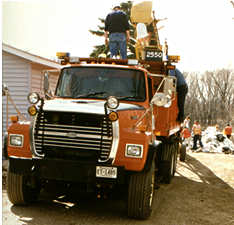 |
|
Workers from the Metro
Division fill sandbags as volunteers fought to hold back the Mississippi
River near Newport during the floods of 1997. Photo by Kevin Walker
|
1997 floods create widespread devastation
The devastating floods of 1997 presented a critical challenge to Mn/DOT people
and resources. Already battered by a winter marked by a series of severe storms
that taxed their energy and resources, Mn/DOT people needed a respite. It didn’t
come—but the floods and their aftermath did.
The widespread floods severed roads, threatened bridges and created stress
on much of the state’s highway system. Mn/DOT people, however, responded with
their characteristic mix of dedication, courage and resourcefulness.
In some locations, workers quickly switched from plowing ice off roads to setting
up detours, building dikes, hauling fill for damaged shoulders and flagging
motorists through water-covered highways—anything that could make travel feasible.
Dave Dalager, maintenance superintendent at Crookston, recalls the way Bemidji
District employees pulled together to combat the widespread flooding.
"The floods of 1997 showed one thing—Mn/DOT forces are resourceful,"
he said. "We could respond and go to the areas where the need was and get
the job done."
Were it not for Mn/DOT’s quick response, the city of Oslo on Hwy 1 would have
been cut off by the floods.
"We found a gravel pit for aggregate to repair washed out parts of Hwy
1 so that we were dumping fill and rebuilding the road as the water was receding,"
he added. "We pulled together to do what needed to be done. We didn’t mess
around—we just did it."
Near Crookston, Larry Tester, a transportation generalist at Dilworth, escorted
an ambulance through a flooded road near Felton to aid three men whose car had
skidded off the road and was frozen into a muddy ditch. One man was found in
a nearby farmhouse, tearing off his clothes in the hysteria associated with
hypothermia. The others were so stiff from the cold they could barely bend enough
to enter the ambulance. They all later recovered.
Elsewyere, rapidly rising floodwaters forced the crew at the Breckenridge Truck
Station to move their trucks out. They worked around the clock for days battling
the flood, taking time off only to secure their own homes.
In the Minnesota River Valley, employees from the Willmar and Mankato districts
worked valiantly to minimize damage to the region’s roads and bridges. In the
Twin Cities region, Metro Division employees hustled Jersey barriers into place
overnight along I-35W to prevent flooding in a low-lying area near the Minnesota
River.
Once the floodwaters receded, Mn/DOT people switched to the recovery mode,
re-opening roads and repairing roadways and shoulders damaged by the rushing
water.
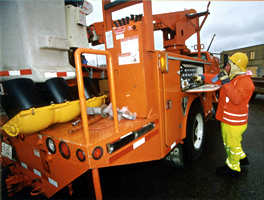 |
|
Mike Jordan, a signal
technician from the Duluth District, prepares to replace a traffic signal
on Hwy 169 damaged when a tornado struck St. Peter in 1998. Photo by
Craig Wilkins
|
Twisters hit southern Minnesota
In 1998, Mn/DOT employees again encountered the forces of nature. In March,
tornadoes destroyed large sections of St. Peter and most of the small city of
Comfrey in Brown County.
Mn/DOT crews were on the scene almost immediately after the twisters struck,
assessing damage, removing downed trees and repairing highway signal systems.
Hwy 169 was closed through St. Peter to keep gawkers out and allow rescue crews
to travel unimpeded.
Tim Sheehy, now maintenance superintendent at Virginia, recalls the situation
at St. Peter when he was the maintenance supervisor at the nearby Le Sueur Truck
Station.
"We had more than 100 people in St. Peter clearing debris, working with
counties, cities and volunteer fire departments," he said. "We had
one section of town to clear. I remember the smell of natural gas and seeing
downed power lines all over the place."
"We ran our crews 14 to 16 hours a day during that first week," he
said.
In the year 2000, Mn/DOT employees faced the aftermath of another tornado in
Granite Falls and flooding in southeastern Minnesota.
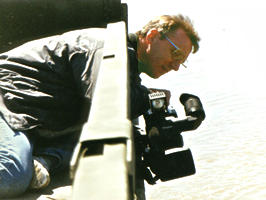 |
|
Leaning over the flooding
Red River of the North, Gary Andrist, Communications and Public Relations,
helps document the devastation caused in Northwestern Minnesota and North
Dakota by widespread flooding in 1997. Photo by Gary Ruud
|
Already battered by the floods of 1997, Granite Falls took another hit from
a twister spawned from a summer storm in July 2000. Mn/DOT crews were on the
scene almost immediately, barricading Hwy 212 and cutting and hauling brush
to clear paths in the stricken city. The Marshall sign shop crew made directional
signs to help volunteers find parking and to replace signs lost during the storm.
The region experienced heavy snowfalls during the winter of 2000-2001, which
resulted in more spring flooding.
Denny Marty, regional maintenance supervisor at Willmar, said the winter snowfall
often required his forces to use snowblowers and bulldozers 24 hours a day to
keep the roads cleared. The floods struck cities such as Granite Falls, Madison
and Montevideo and damaged highways in the region.
One road, Hwy 40 at Milan, was under water for three weeks, he said.
"We had the tornado and then the snow and then the floods but the guys
kept going at it," Marty said. "Ask them why and they’ll say it’s
just part of the job."
Floods damage roads in southeastern Minnesota
The Root River left its banks and caused widespread damage in the Rochester
District in June and July of 2000. The river tore chunks of pavement from Hwy
250 and caused flooding on Hwy 16 near Hokah, Hwy 43 at Choice and other locations.
Near Hokah, Greg Husmann, supervisor at Dresbach, and members of his crew helped
farmer Jerry Welke rescue his cattle from the swollen river by herding them
along Hwy 16 to safety.
Dave Redig, Rochester maintenance superintendent cited several examples of
employee dedication during the floods. He recalled that one evening when he
left Hokah at 8 p.m., Scott Dolle and Scot Allen were flagging along Hwy 16.
When Redig returned to work at 6 a.m. they were still there to make sure motorists
could get through the flooded road safely.
‘Everyday acts of heroism’
In the sweep of major events such as floods and blizzards, everyday acts of
heroism can be overlooked. Many, however, have been recognized.
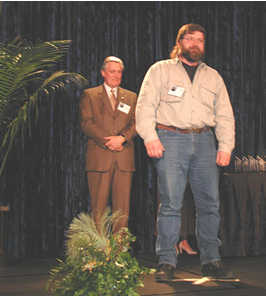 |
|
Chris Cheney, transportation
generalist at Togo, receives an award from Commissioner Elwyn Tinklenberg
at the 2001 Transportation Conference for saving the life of a woman last
winter. Photo by Maureen Talarico
|
Chris Cheney, transportation generalist at Togo, is credited with saving the
life of a woman who fell last winter after crossing the highway to get her mail.
She had broken her leg and would have perished in the minus-20 temperatures
if Cheney hadn’t noticed her during his second pass through town.
The Detroit Lakes District honored five employees for heroism in recent years.
Roger Sazama and Dave Graham were cited for coming to the aid of a woman being
assaulted by a man in her car. The woman jumped from the car seeking help. Sazama
and Graham responded, and called for help. Their action, a State Patrol officer
said, saved the woman from further harm and helped to capture the assailant.
In 1999, Dave Soyring and Jeff Leff from Mahnomen helped save the life of an
accident victim by stopping the flow of blood. They received the State Patrol’s
lifesaving award for their quick reaction.
And earlier this year, Steve Rice, Dilworth, found a motorist whose car had
run off the road during a winter storm. Recognizing the danger if she stayed
in the vehicle, Rice took the driver to safety. While away from the scene, another
vehicle struck the parked car. Rice’s quick action saved the woman from being
injured.
While it takes courage to look into the eye of a storm, it also takes courage
to look into the eyes of those who have suffered a great personal loss.
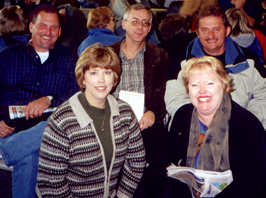 |
|
Members of Mn/DOT's
Critical Incident Stress Debriefing Team take time out for a photo before
boarding a flight to New York to work with employees of the NY DOT whose
offices were destroyed in the Sept. 11 terrorist attack. Team members
are (front) Kay McDonald and DeLorah Curry and (back row) Brad Powers,
Richard Lehmann and Tony Kilpela.
|
Last week, five members of Mn/DOT’s Critical Incident Stress Debriefing Team
traveled to New York to work with employees of the New York DOT transit office
whose offices were in the World Trade Center. Three of the transit employees
died in the Sept. 11 terrorist attack.
Led by DeLorah Curry, staff psychologist, Human Resources, the team met with
groups of employees to help them deal with the tragic aftermath of the attack.
"Our work was difficult and memorable and unprecedented in many ways,"
Curry said. "Their experiences were horrendous and their fears were qualitatively
different as a result of the magnitude of the attack. It was a great opportunity
for us to help."
"Their stories were almost unbelievable," said team member Kay McDonald,
Information Resource Management. "I went because I was genuinely interested
in helping. It was an honor to be asked to go."
The day-to-day courage shown by Mn/DOT people may escape public notice, but
employees’ co-workers recognize their colleagues’ contributions in many ways.
There are awards and citations, but mainly there is respect.
Arvid Lovig, now retired and living near Alexandria, recalls employees who
were on duty plowing snow for weeks on end without complaining, even during
holidays. He also recalls their ability to think on their feet and devise quick
solutions to pressing problems.
And he remembers the willingness of Mn/DOT people to step up and quietly do
what’s needed.
"I couldn’t make people go out in situations like the blizzard of 1984,"
he said, "but I always had enough volunteers."
By Craig Wilkins
|


